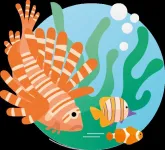(Press-News.org) KEY TAKEAWAYS
Brigham researchers assessed data from more than 27,000 participants in the Women’s Health Study who were followed for 30 years.
An initial, one-time measure of three biological markers—hsCRP, LDL-cholesterol and lipoprotein(a)—in their blood predicted their risk of major cardiovascular events over the following decades.
The findings support universal screening for inflammation and lipoprotein(a) in addition to cholesterol, as well as earlier, aggressive use of targeted interventions, particularly among women for whom cardiovascular disease remains underdiagnosed and undertreated.
Investigators from Brigham and Women’s Hospital, a founding member of the Mass General Brigham healthcare system, shared new insights about women’s health and cardiovascular risk, finding that measurement of three independent biological markers in a blood sample can better predict risk of major cardiovascular events over the next three decades than measuring only one. In a landmark study of 27,939 initially healthy American women presented at the European Society of Cardiology (ESC) Congress in London and published simultaneously in the New England Journal of Medicine, a single measure of high-sensitivity C-reactive protein (hsCRP, a marker of vascular inflammation), low density lipoprotein cholesterol (LDL-C or “bad cholesterol”), and lipoprotein(a) (Lp(a), a genetically determined lipid fraction), strongly predicted cardiovascular risk over an unprecedented 30-year follow-up period.
“Doctors cannot treat what they don’t measure,” said lead author Paul Ridker, MD, director of the Center for Cardiovascular Disease Prevention at Brigham and Women’s Hospital, who presented the findings at ESC Congress 2024. “To provide the best care for our patients, we need universal screening for inflammation, cholesterol, and lipoprotein(a), and we need it now. By so doing, we can target our treatments to the specific biologic need of individual patients, fulfilling our longstanding hope to provide truly personalized preventive care.”
The research team analyzed data from the Women’s Health Study (WHS), funded by the U.S. National Institutes of Health (NIH) through research grants to preventive cardiology investigators in the Division of Preventive Medicine at the Brigham. The landmark trial began in 1993 and has followed female health professionals aged 45 years and older ever since. Women had their hsCRP, LDL-C and Lp(a) levels tested in a blood sample obtained when they enrolled in the WHS. The primary endpoint of the study was a first major adverse cardiovascular event—heart attack, coronary revascularization, stroke, or death from cardiovascular causes.
A Wake-Up Call for Women
To assess each marker as well as the combined effect of having elevated levels of two or all three, the research team divided participants into five quintiles, ranging from those with the highest to the lowest levels of the markers. Researchers found that, compared to women with the lowest levels of individual markers:
Women with the highest levels of hsCRP had a 70% greater risk of a major cardiovascular event;
Women with the highest levels of LDL-C had a 36% greater risk;
Women with the highest levels of Lp(a) had a 33% greater risk.
While hsCRP was the strongest of the three biomarkers, all mattered greatly. Women who had elevated levels of all three markers were 2.6 times more likely to have a major adverse cardiovascular event. This association was even stronger for stroke—women with the most elevated levels were 3.7 times more likely to have a stroke over the next 30 years.
“These data should be a wake-up call for women,” said co-author Julie Buring, ScD, principal investigator of the WHS and an epidemiologist in the Brigham’s Division of Preventive Medicine. “Waiting until women are in their 60s and 70s to initiate heart attack and stroke prevention is a prescription for failure.”
Reducing Risk
Each of the three risk factors is modifiable with a combination of lifestyle changes and drug therapy. Multiple randomized trials have demonstrated that lowering cholesterol and lowering inflammation both significantly reduce risks of heart attack and stroke. Further, several new drugs that markedly reduce Lp(a) as well as second-generation anti-inflammatory agents are being tested to see if they too can lower rates of clinical events.
The new data strongly support earlier and more aggressive use of targeted preventive interventions, particularly among women for whom cardiovascular disease remains underdiagnosed and undertreated.
“While we still need to focus on lifestyle essentials like diet, exercise, and smoking cessation, the future of prevention is clearly going to include combination therapies that target inflammation and Lp(a) in addition to cholesterol,” said Ridker.
Authorship: In addition to Ridker, BWH authors include epidemiologists Julie Buring and I-Min Lee, data analyst Vinayaga Moorthy, and biostatistician Nancy Cook. Additional authors include Nader Rifai.
Disclosures: Ridker has received research grant support to the Brigham and Women’s Hospital and/or served as a consultant to entities developing preventive strategies and treatments that target inflammation, cholesterol, and lipoprotein(a), including support from Novo Nordisk, Novartis, Pfizer, Agepha, and Kowa. Full disclosure forms provided by the authors are available with the full text of this article at NEJM.org.
Funding: Supported by grants (HL043851, HL080467, and HL099355) from the National Heart, Lung, and Blood Institute and grants (CA047988 and CA182913) from the National Cancer Institute, National Institutes of Health.
Paper cited: Ridker PM et al. “Inflammation, Cholesterol, Lipoprotein(a), and 30-Year Cardiovascular Outcomes in Women” NEJM DOI: 10.1056/NEJMoa2405182
###
END
Patients with heart failure, a condition affecting more than 60 million worldwide, are four times more likely to receive the optimal combination of medications after 12 weeks of digital consultations. Researchers from five Dutch hospitals, coordinated by Amsterdam UMC, found that the use of digital consults improved care while maintaining patient satisfaction. These results are published today in Nature Medicine and simultaneously presented at the annual conference of the European Society of Cardiology.
"During the COVID-pandemic almost all of our patients were suddenly digital consult patients and, to be honest, this worked well but there were also ...
Tokyo, Japan – A research team led by Professor Kotohiro Nomura from Tokyo Metropolitan University has developed a method for the depolymerization of PET (polyethylene terephthalate) using alcohols and an inexpensive, readily available iron trichloride catalyst. This method can be applied to the selective chemical recycling of both textile and plastic waste mixtures.
Plastic waste is a significant environmental issue that requires urgent attention. However, the rate of plastic reuse (material recycling) remains low, particularly in the case of chemical recycling into raw materials, a process known as chemical recycling. Polyesters, which ...
A new species of Antarctic dragonfish, Akarotaxis gouldae or Banded Dragonfish, has been discovered in waters off the western Antarctic Peninsula by researchers at William & Mary’s Virginia Institute of Marine Science (VIMS). The species, named in honor of the recently decommissioned Antarctic research and supply vessel (ARSV) Laurence M. Gould and its crew, exemplifies both the unknown biodiversity and fragile state of the Antarctic ecosystem.
Described in the journal Zootaxa, Akarotaxis gouldae was initially identified through genetic analysis. Larval specimens collected off the coast of Antarctica while trawling for zooplankton ...
At the peak of the COVID-19 pandemic in 2021, governments and health care centers across the country faced a difficult but important question: Should health care workers be required to obtain the COVID-19 vaccine?
It was an economic quandary as much as an ethical one. Vaccine mandates could cause reductions in staff, either from workers missing time due to recovery from the vaccine or from opting to seek employment elsewhere. Additionally, health care workers are highly educated on the value of vaccines and had seen ...
AMHERST, Mass. -- New research from the Mechanical and Industrial Engineering Department at the University of Massachusetts Amherst, in collaboration with the Elaine Marieb Center for Nursing and Engineering Innovation, is helping to identify barriers to physical activity in nurses. Published in PLOS ONE, the study reports that the key factors influencing exercise include intrinsic motivation, certain types of social support, certain demographic identifiers and the use of health-tracking technology.
Nursing is a notoriously exhausting career, marked by irregular and long shifts and high physical demands. At the same time, prior studies show that about half ...
Auburn University’s Department of Physics has been awarded two significant National Science Foundation (NSF) grants, marking a major step toward transforming physics education across all levels—from introductory courses to graduate studies. The grants, led by Assistant Professor Eric Burkholder, a specialist in Physics Education Research, aim to close the gap between traditional physics instruction and the complex problem-solving skills needed for real-world scientific challenges.
The cornerstone of these projects is the recognition that traditional methods of teaching physics—while ...
A recent study finds that hope appears to be more beneficial than mindfulness at helping people manage stress and stay professionally engaged during periods of prolonged stress at work. The study underscores the importance of looking ahead, rather than living “in the moment,” during hard times.
Mindfulness refers to the ability of an individual to focus attention on the present, in a way that is open, curious and not judgmental. Essentially, the ability to be fully in the moment.
“There’s a lot of discussion ...
Since the 1960s, astronomers have wondered how the Sun’s supersonic “solar wind,” a stream of energetic particles that flows out into the solar system, continues to receive energy once it leaves the Sun. Now, thanks to a lucky lineup of a NASA and an ESA (European Space Agency)/NASA spacecraft both currently studying the Sun, they may have discovered the answer — knowledge that is a crucial piece of the puzzle to help scientists better forecast solar activity between the Sun and Earth.
A paper published in the Aug. 30, 2024, issue of the journal Science provides persuasive ...
Worldwide survey by Goethe University FrankfurtFRANKFURT. Of the estimated 10 million, mostly still undiscovered species of flora and fauna on Earth, one million could become extinct in the next decades. This loss of biodiversity would have dramatic consequences, as animals and plants are providers of multiple services: They maintain ecosystems, ensure a more balanced climate on our planet, and supply us with food and active substances for medical drugs. Put bluntly: Without biodiversity, we humans will not survive.
That is why there is an urgent need for resolute political measures to counter the “sixth mass extinction” in Earth’s history. One group of people who are particularly ...
The only Injury Control Research Center in Texas has been established by the Centers for Disease Control and Prevention at UTHealth Houston in partnership with Baylor College of Medicine.
“I’m beyond thrilled to bring an Injury Control Research Center to Texas,” said Jeff Temple, PhD, director of the new center and associate dean for clinical research at UTHealth Houston School of Behavioral Health Sciences. “This collaboration between the community, policymakers, UTHealth Houston, and Baylor College of Medicine will undoubtedly save lives.”
An Injury Control Research ...



